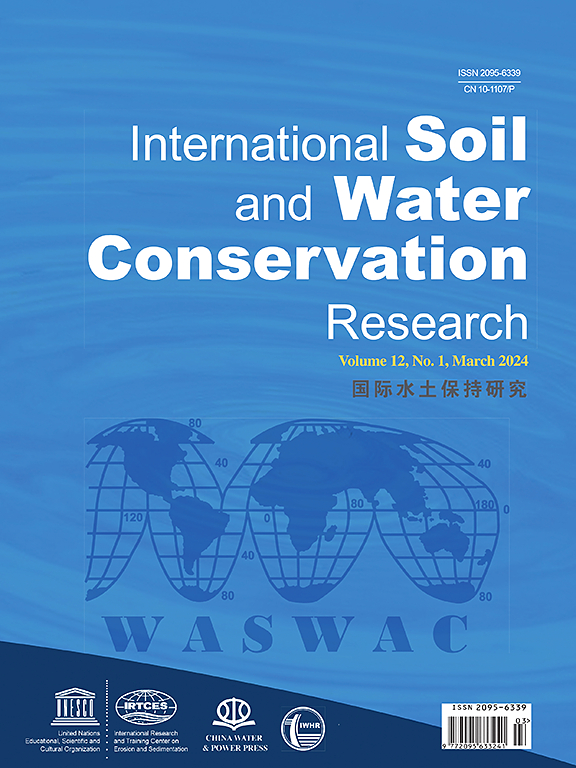Improving the Landsat-8 determinations of soil organic carbon and total nitrogen stocks through reducing the effects of buildings, water, and vegetation
IF 7.3
1区 农林科学
Q1 ENVIRONMENTAL SCIENCES
International Soil and Water Conservation Research
Pub Date : 2025-06-13
DOI:10.1016/j.iswcr.2025.06.004
引用次数: 0
Abstract
Soil mapping using Landsat-8 provides potential for a real-time synoptic estimation of soil organic carbon (SOC) and soil total nitrogen (STN) stocks. However, the few relevant studies at global and European scales have shown relatively poor model accuracy because of the effects from buildings, water and vegetation. Here, we used independent variable fuzzy learning based on several building, water and vegetation indices to reduce the effects of these land covers on the SOC and STN models. We applied the models to predict the SOC and STN stocks at the pan-European scale. Measured SOC and STN stocks obtained from the Land Use/Cover Area frame statistical Survey 2018 dataset and spectral data from the corresponding Landsat-8 images were used in this study. The results indicated that the SOC and STN models after learning performed better than the models before learning (the SOC model: R2 = 0.56, mean absolute error (MAE) = 10.38 t C ha−1, root mean squared error (RMSE) = 13.72 t C ha−1, ratio of performance to interquartile range (RPIQ) = 2.02; the STN model: R2 = 0.52, MAE = 0.92 t N ha−1, RMSE = 1.20 t N ha−1, RPIQ = 1.45). The two models predicted the 0–20 cm SOC and STN stocks across Europe as 28.13 and 2.25 Gt, respectively. The uneven distributions were clearly reduced when compared with the maps before learning, especially our STN map and STN relative standard deviation (RSD) map. The results indicated that our study provided a valuable reference for reducing the effects of buildings, water, and vegetation during satellite SOC and STN mapping. Considering the importance of SOC and STN for future global policies, we will also pay attention to the effects of other soil properties, weathering and land covers in the future.
通过减少建筑物、水和植被的影响,改进Landsat-8测定土壤有机碳和总氮储量
利用Landsat-8进行土壤制图为土壤有机碳(SOC)和土壤全氮(STN)储量的实时天气估计提供了可能。然而,在全球和欧洲尺度上的少数相关研究表明,由于建筑物、水和植被的影响,模式的准确性相对较差。本文采用基于建筑、水和植被指数的自变量模糊学习来降低这些土地覆盖对SOC和STN模型的影响。应用该模型对泛欧尺度上的碳储量和碳储量进行了预测。本研究使用了2018年土地利用/覆盖面积框架统计调查数据集和相应Landsat-8图像的光谱数据获得的实测SOC和STN储量。结果表明,学习后的SOC和STN模型表现优于学习前的模型(SOC模型:R2 = 0.56,平均绝对误差(MAE) = 10.38 t C ha−1,均方根误差(RMSE) = 13.72 t C ha−1,性能与四分位数间距之比(RPIQ) = 2.02;STN模型:R2 = 0.52, MAE = 0.92 t N ha−1,RMSE = 1.20 t N ha−1,RPIQ = 1.45)。两种模式预测欧洲0 ~ 20 cm的碳储量为28.13 Gt, STN储量为2.25 Gt。与学习前的地图相比,不均匀分布明显减少,特别是我们的STN地图和STN相对标准偏差(RSD)地图。研究结果为降低建筑物、水和植被对卫星SOC和STN的影响提供了有价值的参考。考虑到SOC和STN对未来全球政策的重要性,未来我们还将关注其他土壤性质、风化和土地覆盖的影响。
本文章由计算机程序翻译,如有差异,请以英文原文为准。
求助全文
约1分钟内获得全文
求助全文
来源期刊

International Soil and Water Conservation Research
Agricultural and Biological Sciences-Agronomy and Crop Science
CiteScore
12.00
自引率
3.10%
发文量
171
审稿时长
49 days
期刊介绍:
The International Soil and Water Conservation Research (ISWCR), the official journal of World Association of Soil and Water Conservation (WASWAC) http://www.waswac.org, is a multidisciplinary journal of soil and water conservation research, practice, policy, and perspectives. It aims to disseminate new knowledge and promote the practice of soil and water conservation.
The scope of International Soil and Water Conservation Research includes research, strategies, and technologies for prediction, prevention, and protection of soil and water resources. It deals with identification, characterization, and modeling; dynamic monitoring and evaluation; assessment and management of conservation practice and creation and implementation of quality standards.
Examples of appropriate topical areas include (but are not limited to):
• Conservation models, tools, and technologies
• Conservation agricultural
• Soil health resources, indicators, assessment, and management
• Land degradation
• Sustainable development
• Soil erosion and its control
• Soil erosion processes
• Water resources assessment and management
• Watershed management
• Soil erosion models
• Literature review on topics related soil and water conservation research
 求助内容:
求助内容: 应助结果提醒方式:
应助结果提醒方式:


